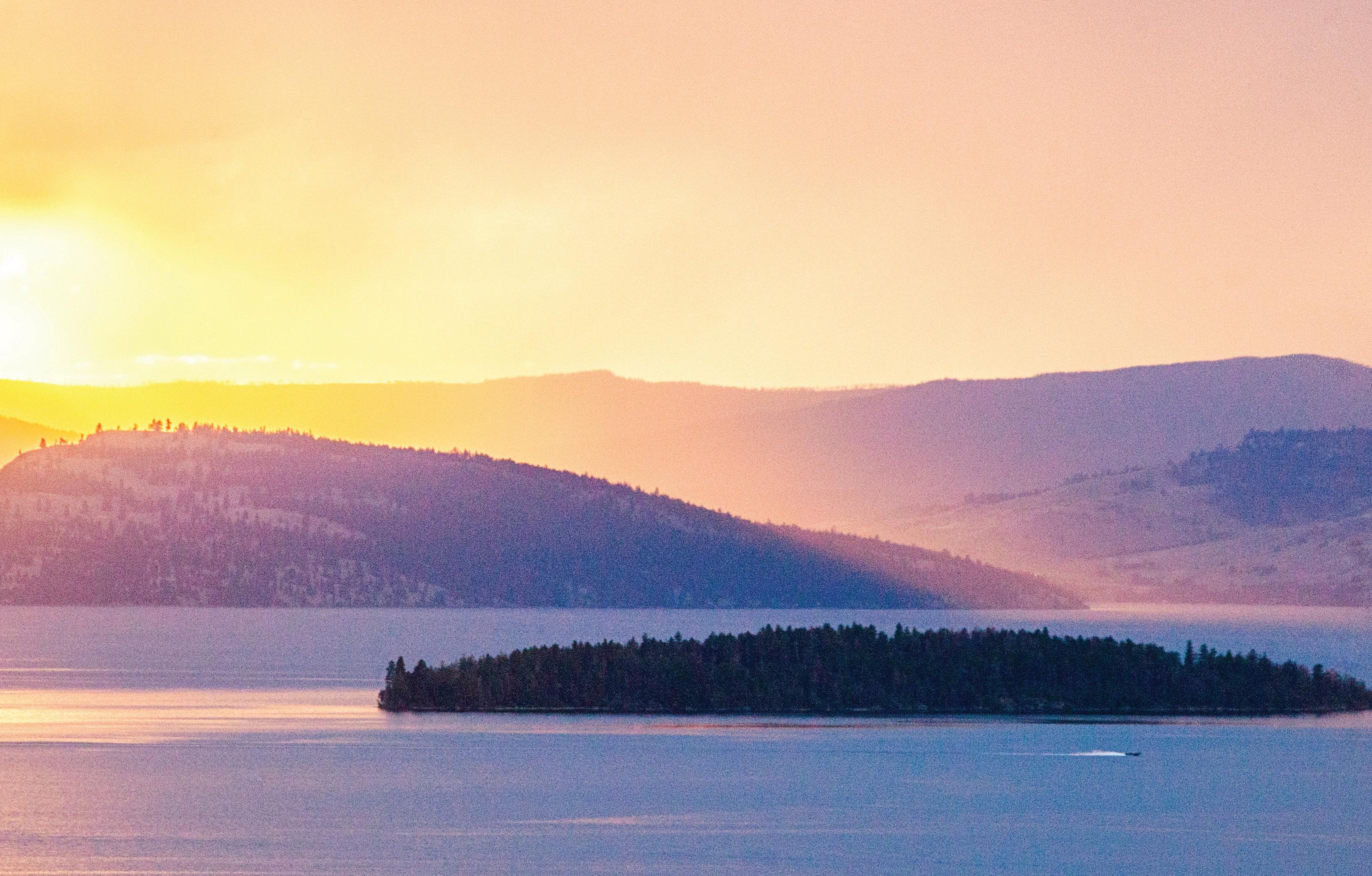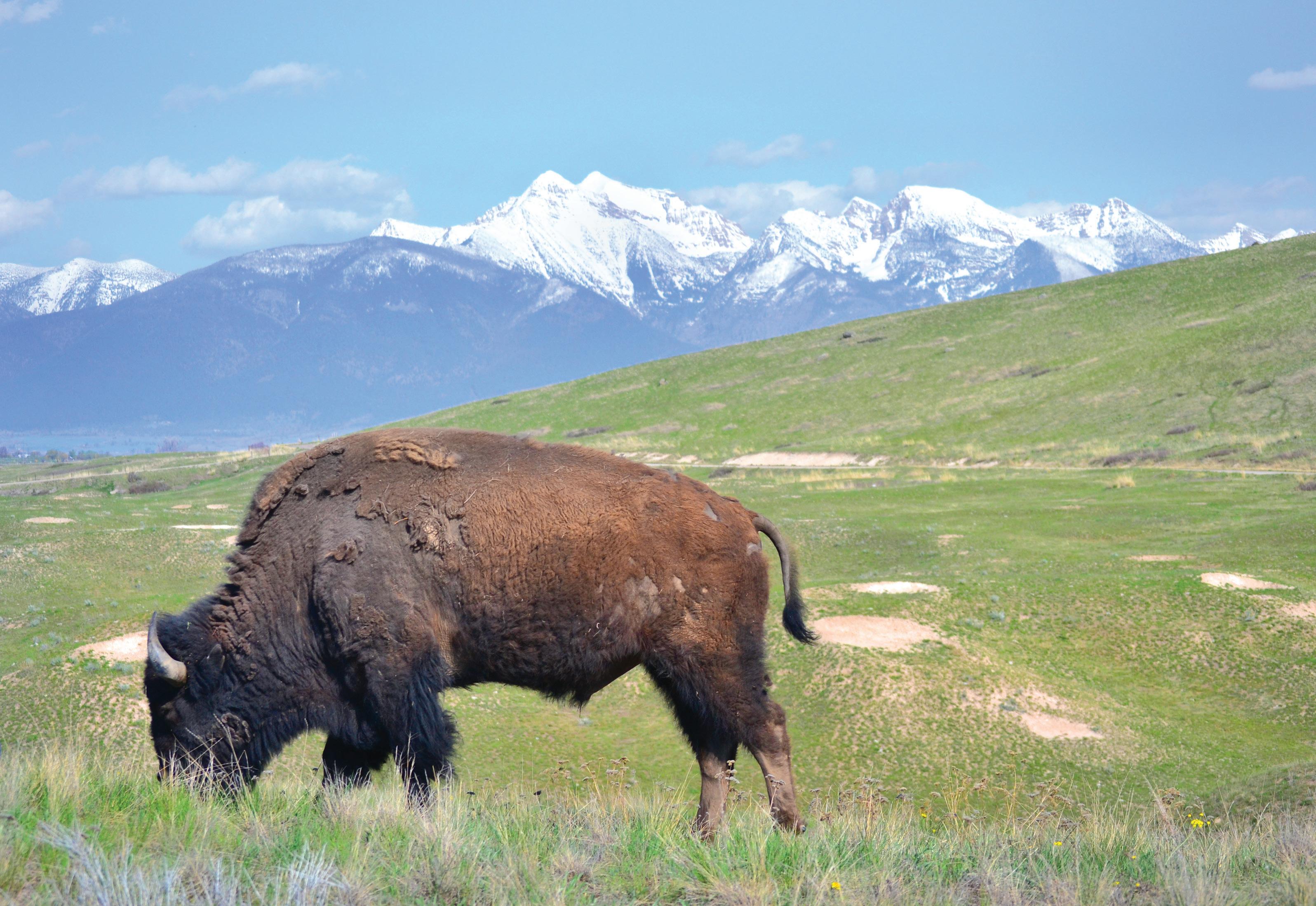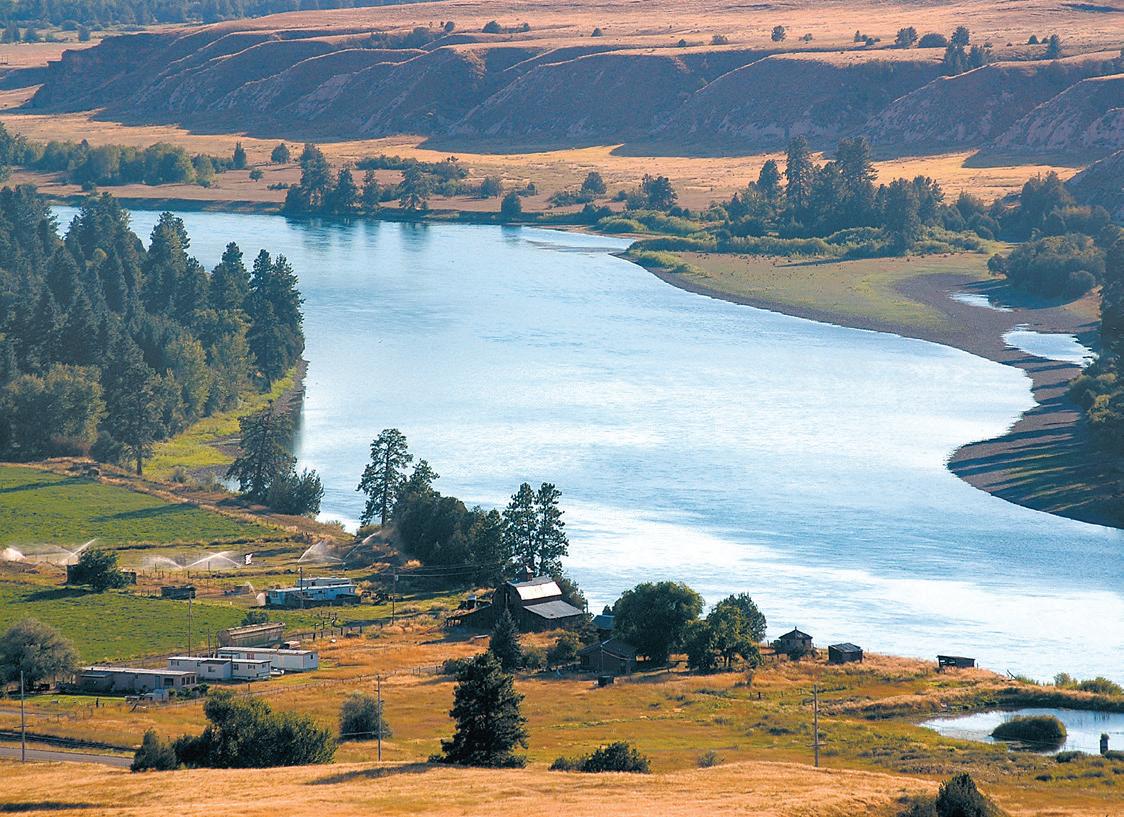
7 minute read
Flathead Lake Islands
FROM PAGE 37
Melita Island comes in at 64 acres. The Boy Scouts of Montana are the owners of this longtime summer camp on Flathead Lake. Melita Island has been a Boy Scout camp since the mid-1930s. Boy Scout campers share the island with mule deer, squirrels, eagles, osprey, geese and woodpeckers. Island activities include a wide variety of water sports like sailing, snorkeling, canoeing and water skiing, designed to challenge both youth and adults.
Bull Island and Little Bull Island are located in the “narrows” of Flathead Lake, an area in the south of the lake separating Polson Bay from the larger portion of the lake to the north. Prior to approximately 1920, Bull Island was also known as Idlewilde Island. The University of Montana Maureen and Mike Mansfield Library houses digitized archives of Native American artifacts found on Bull Island. Little Bull, owned by one family since 1959, houses several buildings and a chapel.
Emerald Island is private one-acre island listed on Airbnb as a rental for $1,709 per night.
Cedar Island’s cedar and pine filled land once belonged to the Marshall family who sold the island to the state in the 1950s. The primary occupants of the island are birds, bats and some raccoons. Overnight camping is allowed.
SHELTER ISLAND

Forallyourrealestateneeds, buyingorselling.

www.westernmontanaland.com
Jackie Smart Broker/Owner Jodie L. Hooker Real Estate Broker 406-239-7588
Dave Dutter Realtor GRI 406-531-9185
Deb Weivoda Realtor GRI 406-249-9859
Bird island is part of a cluster of small islands that make up the Flathead Lake Bird Preserve, which was established by the Montana Legislature in 1947.
FROM PAGE 38
Flathead Lake provides a lifetime worth of both water and land adventures so get started exploring. Research reveals a total of 17 names found for the islands on Flathead Lake: Bird Island, Bull Island, Cedar Island, Cromwell Island, Douglas Island, Dream Island, Emerald Island, Goose Island, Invitation Island, Little Bull Island, Mary B Island, Melita Island, Mother in-law Island, O’Neill Island, Rock Island, Shelter Island, Wildhorse Island. Apart from the publicly managed islands named in this story, others are privately owned and often marked as such with “no trespassing” signs on their shorelines.
For additional information about Wild Horse Island State Park, Flathead Lake and the state-managed islands contact the Flathead Lake State Park Ranger Station at 406837-3041 or visit https://fwp.mt.gov/ stateparks

BIRD ISLAND
Story by Kathi Beeks / Valley Journal, photos by Nicole Tavenner, Summer Goddard
Open Seven days a week Coffee Wraps Bagels Frozen Yogurt


Convenient drive-through • 50599 Hwy 93 • Polson
BISON GRAZING, BISON RANGE

UNITED STATES AND CONFEDERATED SALISH AND KOOTENAI TRIBES FLAGS

Bison Range open under new ownership
BISON RANGE — From a population of 30 to 60 million animals roaming throughout North America, bison reached a low of 100 in the wild in the late 1800s. Since 1908, the Bison Range has played an important role in the successful recovery of these magnificent animals. The fact that we can still see bison on the landscape is one of the finest accomplishments in the history of the National Wildlife Refuge System, according to the U.S. Fish and Wildlife Service.
President Theodore Roosevelt established the National Bison Range on May 23, 1908, when he signed legislation authorizing funds to purchase suitable land for the conservation of bison. It was the first time that Congress appropriated tax dollars to buy land specifically to conserve wildlife. The overall mission of the Bison Range was to maintain a representative herd of bison, under reasonably natural conditions, to ensure the preservation of the species.
In December of 2020, the Bison Range was returned to the Confederated Salish and Kootenai Tribes as part of the Montana Water Rights Protection Act, a historic settlement agreement between the federal government, CSKT and the state of Montana,.
According to CSKT, “Congress passed and the President signed, the Bison Range Restoration legislation. Through Public Law 116260, Congress has now restored the Bison Range to federal trust ownership for the Confederated Salish and Kootenai Tribes. The tribe is currently working with the U.S. Fish and Wildlife Service to transition from federal to tribal management.
“The Tribal Council has adopted, as its interim the Bison Range management plan, the current

Comprehensive Conservation Plan that was developed and adopted by the U.S. Fish and Wildlife Service in 2019 (for which CSKT was a cooperating agency).”
Rich Janssen, who now heads the CSKT Natural Resources Department and is overseeing the turnover for the tribes, stated that the land transfer “has a personal connection to all tribal members. It was a total tribal effort. We are glad to see it finally come to fruition because it was a long time coming.”
According to FWS, the original herd of bison released in 1909 was purchased with private money raised by the American Bison Society and then donated to the refuge. Today, 250-300 bison call the refuge home. The refuge is essentially a small, low-rolling mountain connected to the Mission Mountain Range by a gradually descending spur. Elevation varies from 2,585 feet at headquarters to 4,885 feet at High Point on Red Sleep Mountain, the highest point on the range.
Much of the National Bison Range was once under prehistoric Glacial Lake Missoula, which was formed by a glacial ice dam on the Clark Fork River about 13,000 to 18,000 years ago. The lake attained a maximum elevation of 4,200 feet, so the upper part of the refuge was above water. Old beach lines are still evident on north-facing slopes. Topsoil on the range is generally shallow and mostly underlain with rock which is exposed in many areas, forming ledges and talus slopes. Soils over the major portion of the range were developed from materials weathered from strongly folded pre-Cambrian quartzite and argillite bedrock.
The range is now home to a diverse ecosystem of grasslands, Douglas fir and ponderosa pine forests, riparian areas and ponds. In addition to herds of bison, it supports populations of Rocky Mountain elk, mule deer, white-tailed deer, pronghorn, and bighorn sheep as well as coyotes, mountain lions, bears, bobcat and over 200 species of birds.
Bison and humans have coexisted for a very long time. In North America, flint spear points as old as 1,200 years have been found among bison bones. Native Americans hunted for meat as well as for hides for clothing and shelter. And bison were able to furnish much more – sinew used for bowstrings, hooves boiled to make glue, dung burned as fuel, and toe bones used like dice. The relationship with bison formed the basis of many Plains Indian beliefs, stories and religions.
The local Salish, Pend d’Oreille and Kootenai people convey how important the buffalo is to their traditional way of life. The Confederated Salish and Kootenai Tribes keep their culture vibrant and alive with an annual river honoring, powwows, native language schools and active cultural committees. For more information, visit www.cskt. org.
Bison herds in the Mission Valley date back to the late 1800s when a Pend d’Oreille man of the Flathead Reservation, named tatati (Little Falcon Robe) returned home from the plains of eastern Montana with four bison calves. The herd quickly grew to 13 animals. At that point, partners Michel Pablo and Charles Allard bought the herd. The Pablo-Allard herd thrived in the Mission Valley’s open grasslands. It became one of the largest private bison herds at the time when bison were most threatened with extinction; however, when it was announced the Flathead Indian Reservation would be opened for homesteading in 1910, surviving partner Pablo began making arrangements to rid himself of his herd. The US Government declined to purchase the bison so Pablo
FLATHEAD RIVER AS SEEN FROM BISON RANGE
SEE PAGE 44
Live music Friday Night!
Mission Mountain





Youth events begin at 6:30 p.m. Rodeo 7:30 p.m. both nights!





Food & Beverage Concessions Available
Polson Fairgrounds Arena 883-1100
for more information: www.polsonfairgroundsinc.com Adults $10 • Children under 12 - $5 • 3 & under FREE









